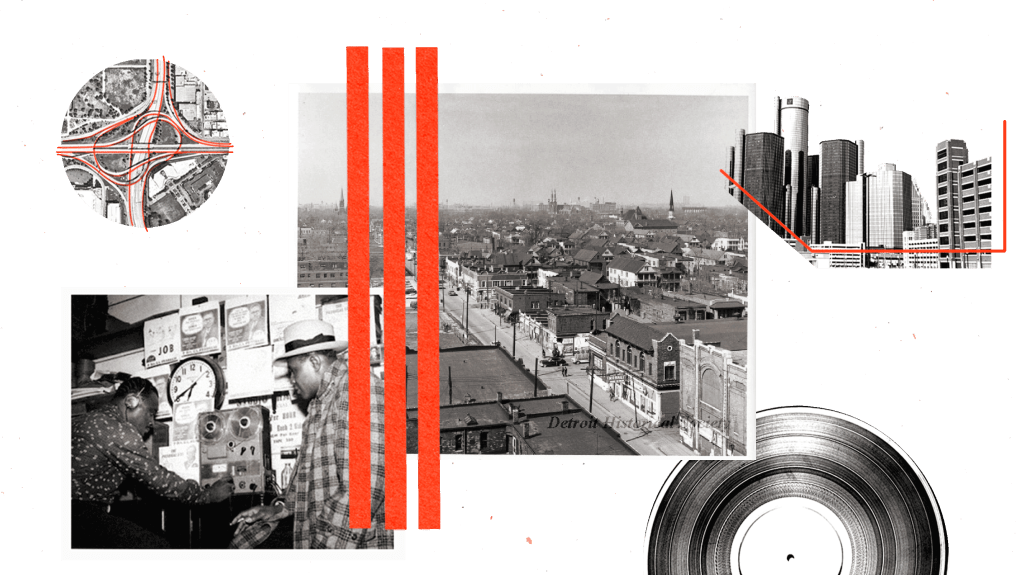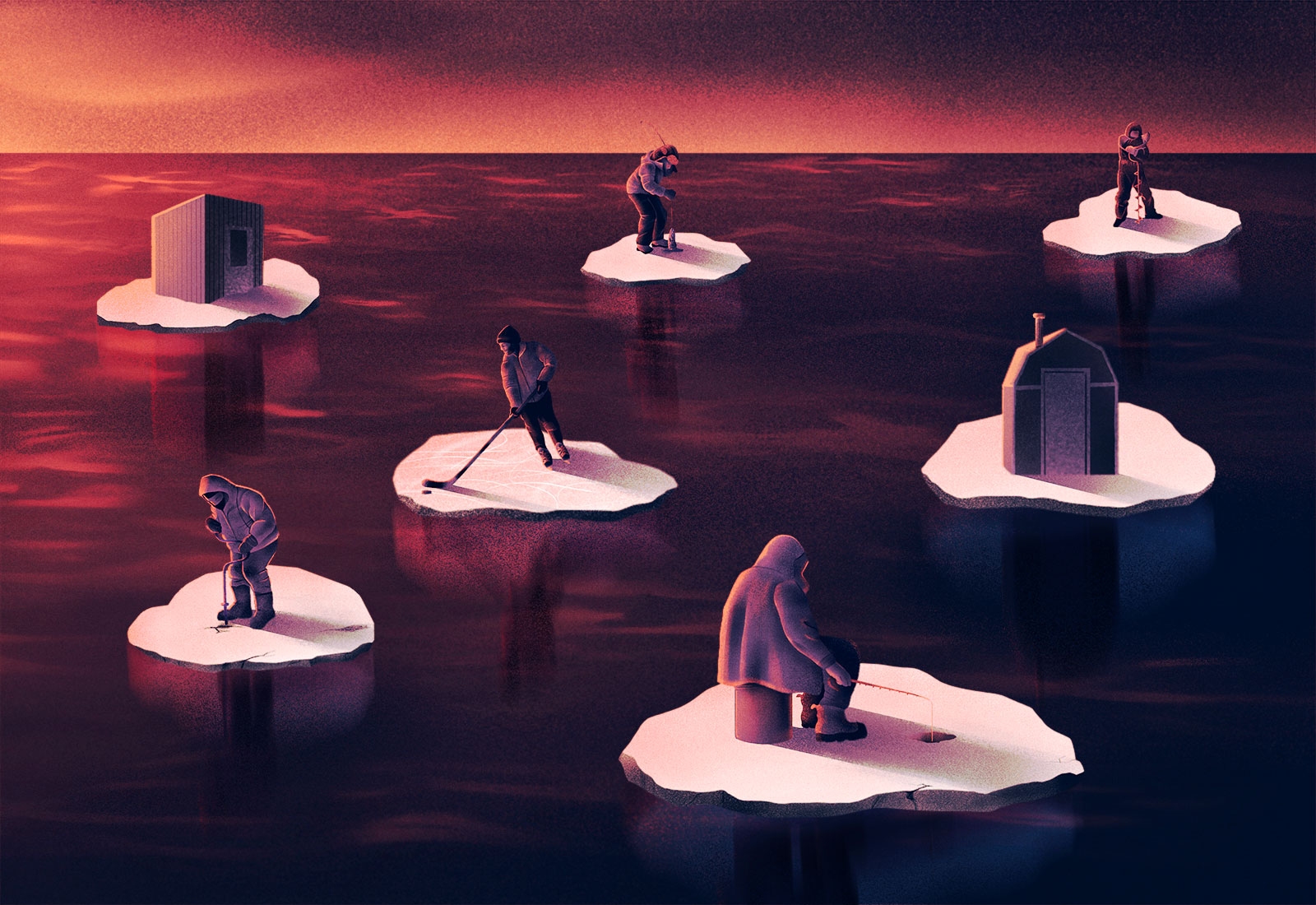Fitted in a heavy, blaze orange coat and pants, fishing rod and spud bar in hand, Tim Sacka stands on the frozen edge of Lake St. Clair. Using the spud bar, he chips away at the ice through a layer of fluffy snow, to uncover a hole drilled the day before. He waits 10 minutes for the water to quiet and settle, then sits down on a five-gallon white plastic bucket and dips his line through the frozen slush. The sun is bright, and it’s quiet on the ice.
Sacka has ice fished on Lake St. Clair, situated between Detroit and Canada, for the last 35 years. Here, he’ll catch perch, bluegill, and every once in a while, a bass.
But in recent decades, his fishing trips have started later and later every winter.
“I used to come before Christmas, but for the last three years it’s been the middle of January,” he said, sitting on his bucket, periodically withdrawing the rod to remove the thin layer of ice that had accumulated on the line. It was late January, and only the second time this winter the lake had been frozen enough for Sacka to safely venture out. In addition to starting later, ice fishing season is shorter now, too. For years, Sacka would fish through March. Now, his season ends in February. Two years ago, the waters on Lake St. Clair didn’t freeze enough for him to go ice fishing at all.
“We’ve lost at least a month,” Sacka said. “It makes me sad.”
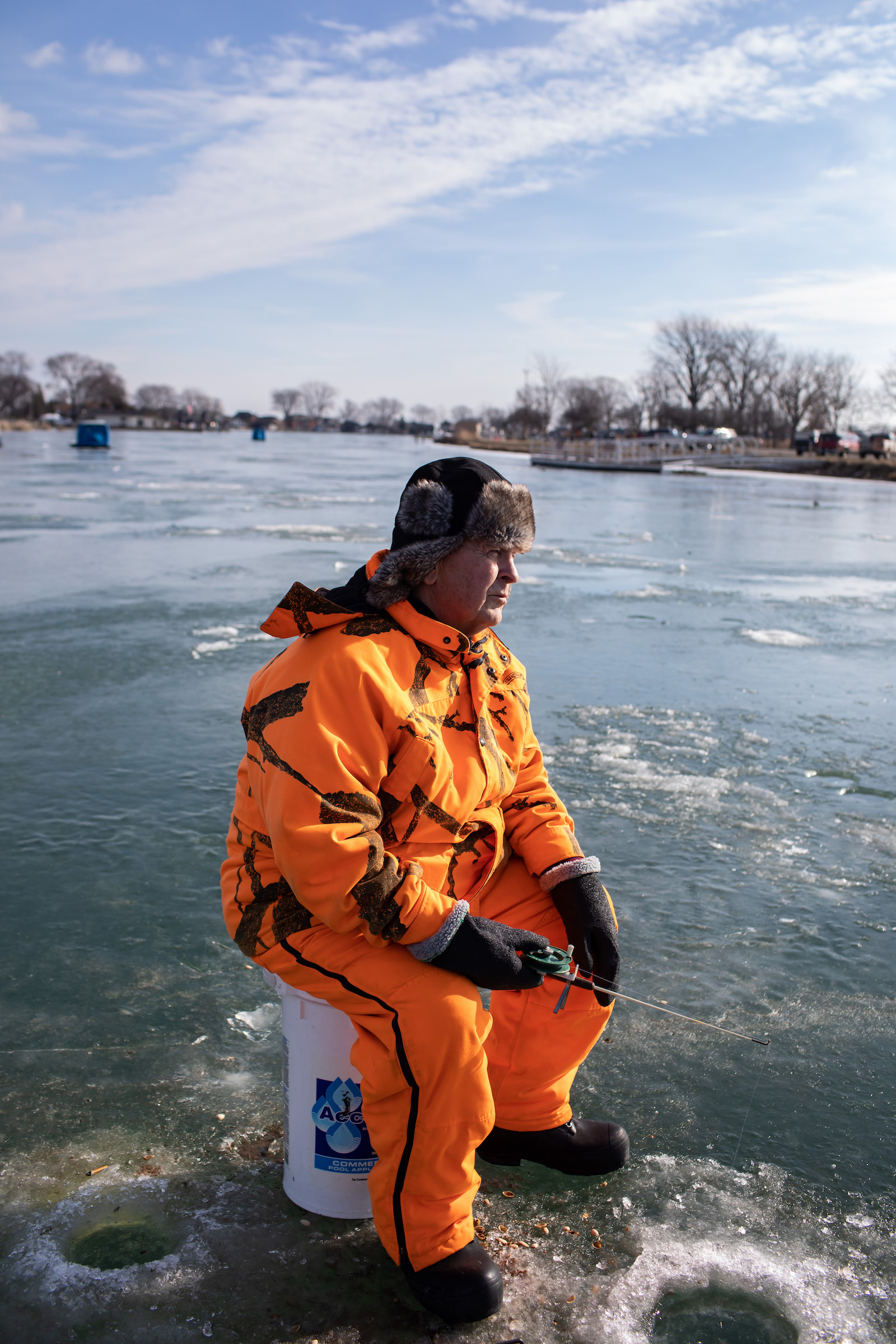
For Midwesterners, winter has long been a point of pride. It is a region where people boast of surviving temperatures below zero before wind chill; where residents don’t just build snowmen, they build ice fishing shacks to drag onto frozen lakes; and where backyard hockey ponds can outnumber swimming pools.
The St. Paul Winter Carnival in Minnesota, the nation’s oldest winter festival, embodies this devotion. The celebration started as a retort to a reporter from New York who, after a visit to Minnesota in the winter of 1885, declared the region “another Siberia — unfit for human habitation.” The event was born soon after to showcase the beauty and joy of living through a winter of snow and ice. This year marks the carnival’s 136th year.
But climate change is altering winter in the Midwest, playing havoc with traditions. Warming temperatures here — as elsewhere — mean the loss of a way of life, of a culture that began generations ago and that many thought their children’s children would celebrate.
Over the last half-century, the Midwest has warmed on average 2.6 degrees Fahrenheit. The change to winter has been even more drastic: Temperatures are now 4 degrees F warmer from December to February than they were in 1980. The Upper Midwest — Wisconsin, Minnesota, and Michigan — is experiencing the fastest winter warming of any region in the lower 48 states.
These climbing temperatures are causing noticeable changes across the region. Lake Superior is one of the fastest-warming lakes in the world. Ice cover on the Great Lakes is, on average, 22 percent lower than it was half a century ago. Last winter, the Great Lakes had their second-lowest ice cover since 1973. The lowest was in 2002, when just 12 percent of the Great Lakes were covered in ice.
This winter is no exception. “There is almost no ice across the Great Lakes right now,” Ayumi Fujisaki-Manome, a research scientist for the Cooperative Institute for Great Lakes Research at the University of Michigan, told Grist in December.
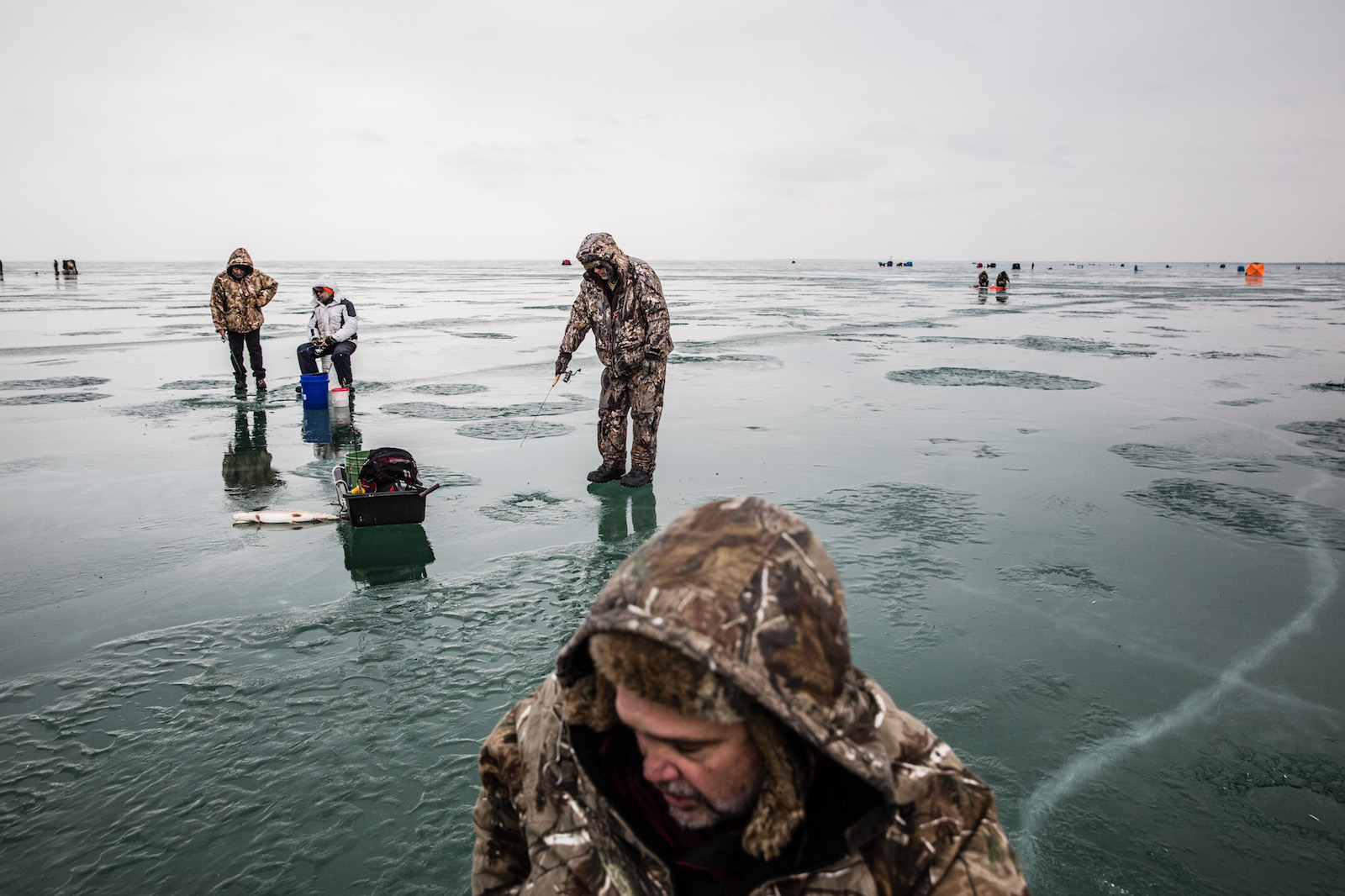
By mid-January, the Great Lakes’ ice cover was at just 3 percent, due to warm weather. A cold snap in early February expanded that to 41 percent, but scientists warned the ice was thin and vulnerable to cracking. On February 6, 18 snowmobilers and ATVers ventured onto Lake Erie and became trapped on an ice floe, drifting away from shore. They had to be rescued by helicopter and airboat by the U.S. Coast Guard and a good samaritan.
As temperatures rise and ice disappears, the beloved winter pastimes and rugged cold-weather mentality that helped to define this region are being threatened. Events that communities look forward to all year have been pushed back, shortened, or eliminated altogether. In some instances, winter enthusiasts can chase their activity further north. In others, like in Indigenous communities, the land hosts time-honored traditions such as maple syrup harvesting and ice fishing that can’t be replaced.
“We as Ojibwe people don’t have the luxury of migrating with those trees that have been taking care of our people for thousands of years,” said Jerry Jondreau. He and Katy Bresette own Dynamite Hill Farms, a 30-acre maple tree farm off the shores of Lake Superior on the Keweenaw Bay Indian Community reservation in the Upper Peninsula of Michigan. “We cannot pick up our reservation and move it north to Canada to maintain that relationship with sugar maple.”

On an overcast weekend late last month, thousands of people gathered in rural Roscommon County, Michigan, for the opening weekend of the annual Tip Up Town USA, the largest and longest-running winter festival in Michigan. Visitors rode in on snowmobiles and ATVs. Families pulled small children on sleds. The crowd clustered on the frozen surface of Houghton Lake, Michigan’s largest inland body of water. A thermometer measured 18 degrees F — mild for a northern Michigan day in the dead of winter. Several inches of snow caked the ground, the lake was frozen across, and a steady snowfall blanketed the event throughout the day.
Started in 1951, the festival today attracts about 30,000 people for ice fishing contests, snowmobiling, races on the lake, and activities for kids. It’s Michigan’s ultimate celebration of winter. And it’s a big deal economically for the unincorporated community of approximately 3,350 people.
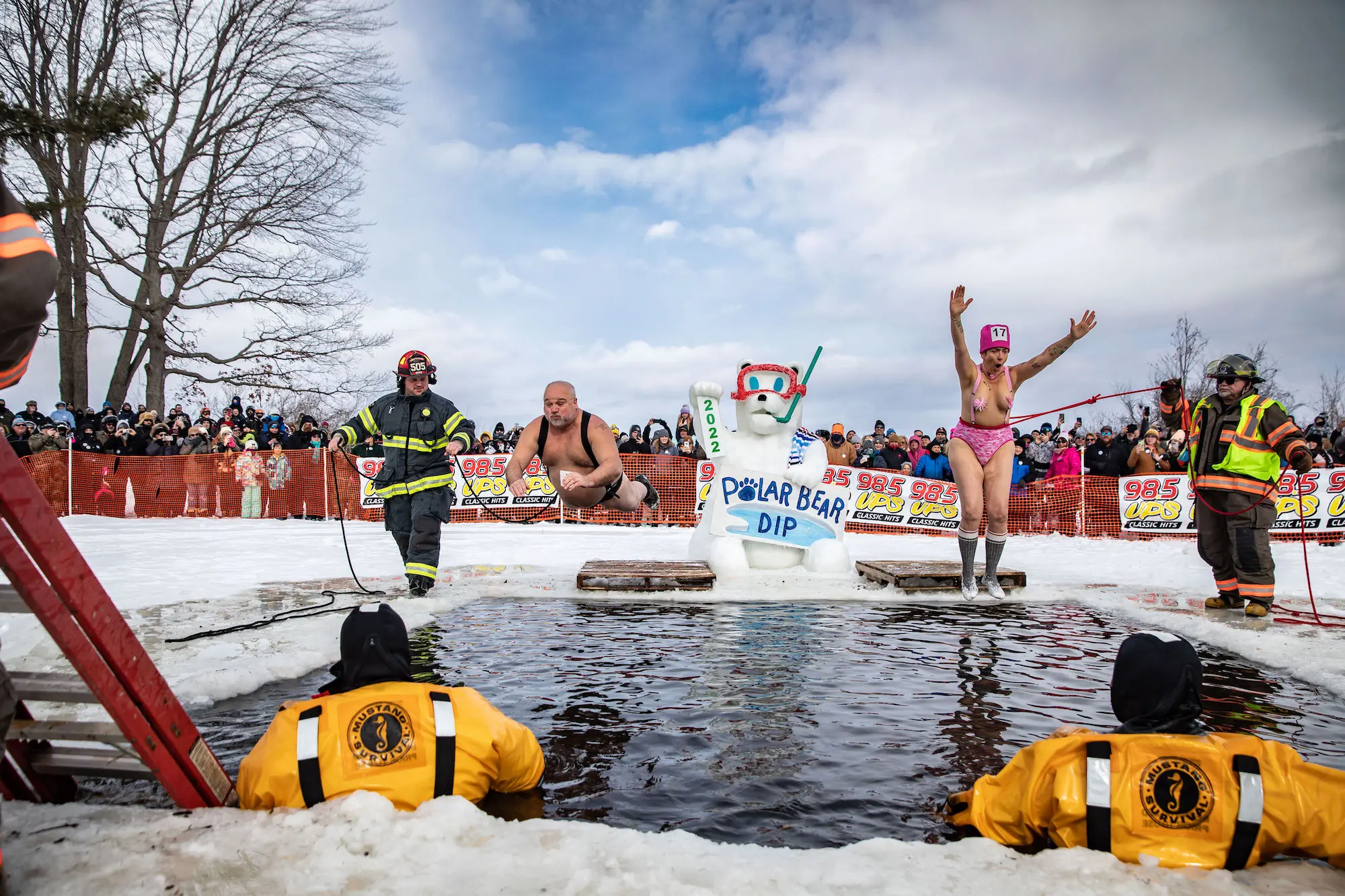
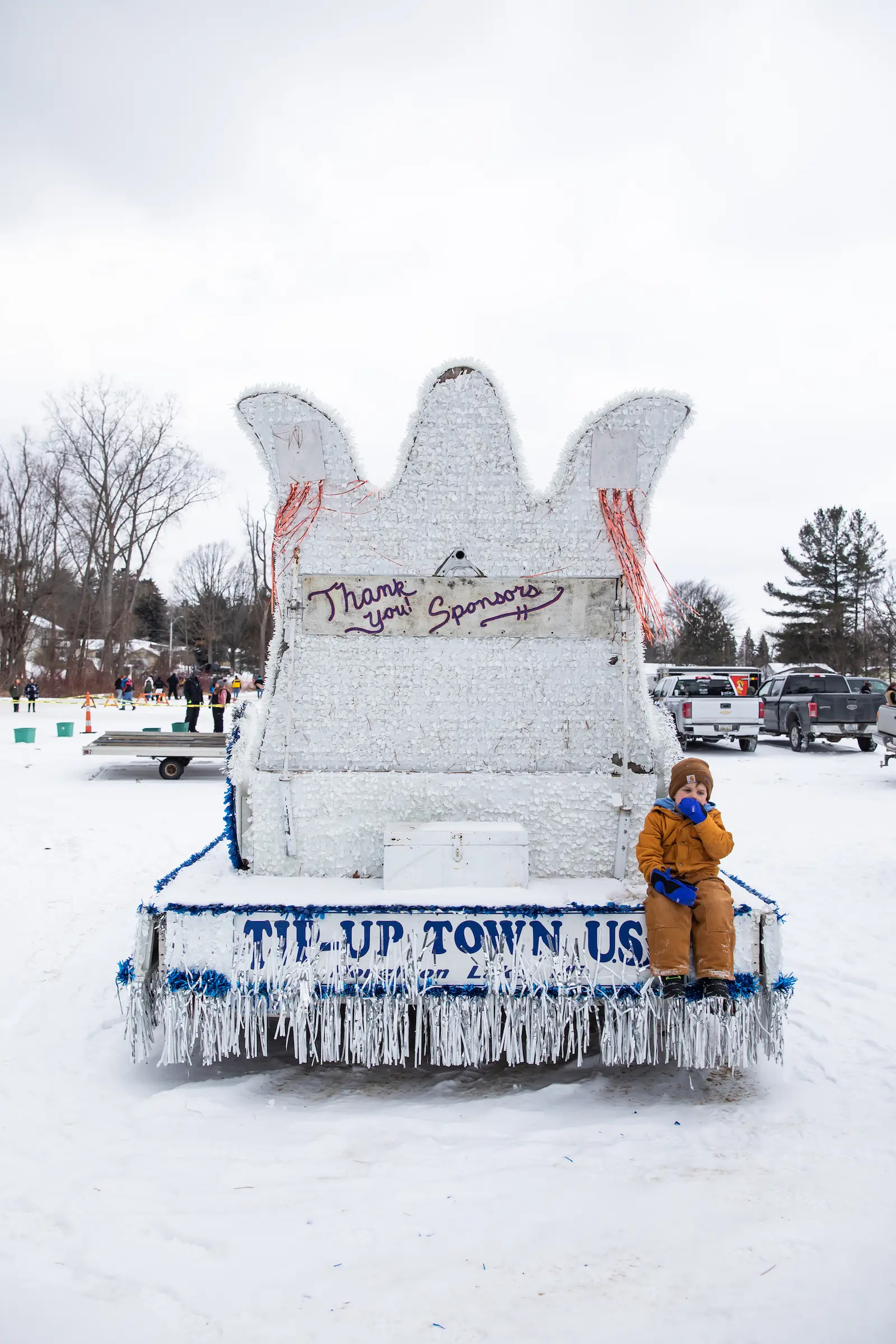
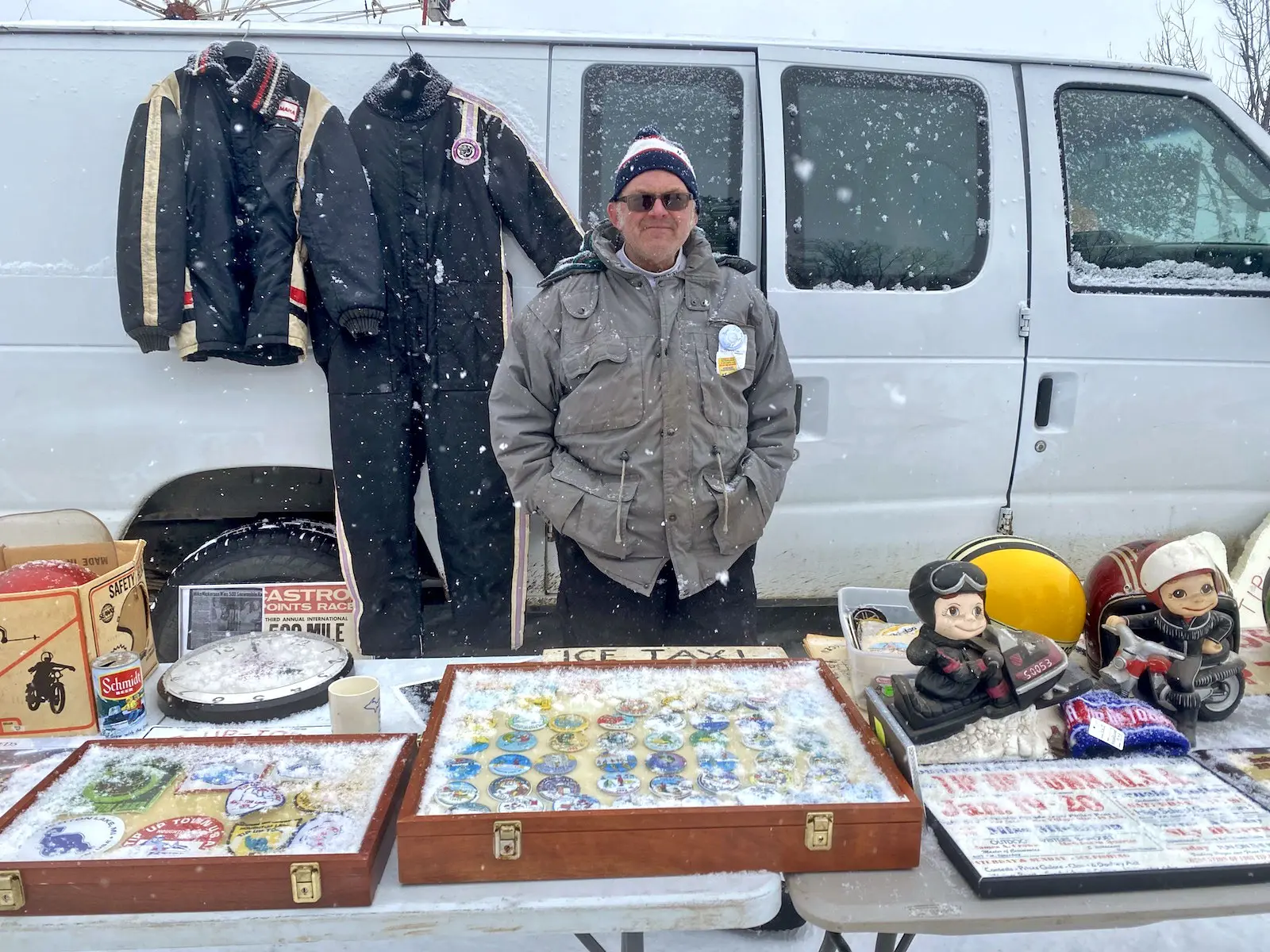
Participants of the 2022 Tip Up Town Festival’s Polar Bear Plunge, left, jump into icy waters. Right, a boy, sits on a float thanking festival sponsors, and Darrell “Double D” LaPaugh displays vintage Tip Up Town patches memorabilia during the 2022 festival. Photos by Amy Sacka and Grist / Jena Brooker
“We are a very tourist-driven economy,” said Jay Jacobs, executive director of the Houghton Lake Chamber of Commerce, the organization that hosts Tip Up Town USA. “We don’t have an industrial park, a defined downtown, a hospital — we don’t have all the basic fundamental economic building blocks that many communities have. So, we’re dependent on one industry, and that’s tourism.”
The night before the start of this year’s festival, a truck and trailer went out on the lake to test the thickness of the ice. Although the 12-inch ice was technically thick enough to be considered safe, a pressure crack formed and the rear tires slipped, falling through the ice and forming a gap of open water.
Shortly after, Jacobs got a call from one of the organizers, in tears. After spending hundreds of hours planning the event, the festival team determined the ice wasn’t safe enough to hold two of its main events: the side-by-side UTV (utility task vehicle) race and the ATV (all-terrain vehicle) race.
“That’s Mother Nature, and it’s unfortunate,” Jacobs said. “We’ve got people driving 14, 15 hours to come to this and they got here and we had to cancel … I’ve been doing this for a lot of years, and occasionally you’ve had somebody go through when we’ve had warmer weather.”
In 2016, a truck and a woman fell separately into the lake during the festival. In 2020, the lake was unfrozen open water just a week before the festival was held. That year nearly a dozen vehicles and their drivers fell through.
Attendees at this year’s event seemed unconcerned, however, continuing to drive their ATVs and snowmobiles just feet from the open water where the testing truck cracked open the ice, the pool blocked off with orange cones and caution tape.
Some yards off the shore, food vendors, carnival rides, ice sculptures, and vintage snowmobiles were set up. Grist spoke with “Double D,” Darrell LaPaugh, a vendor displaying vintage snowmobiles and helmets, Tip Up Town patches, and collector pins from the festival dating back 60 years.
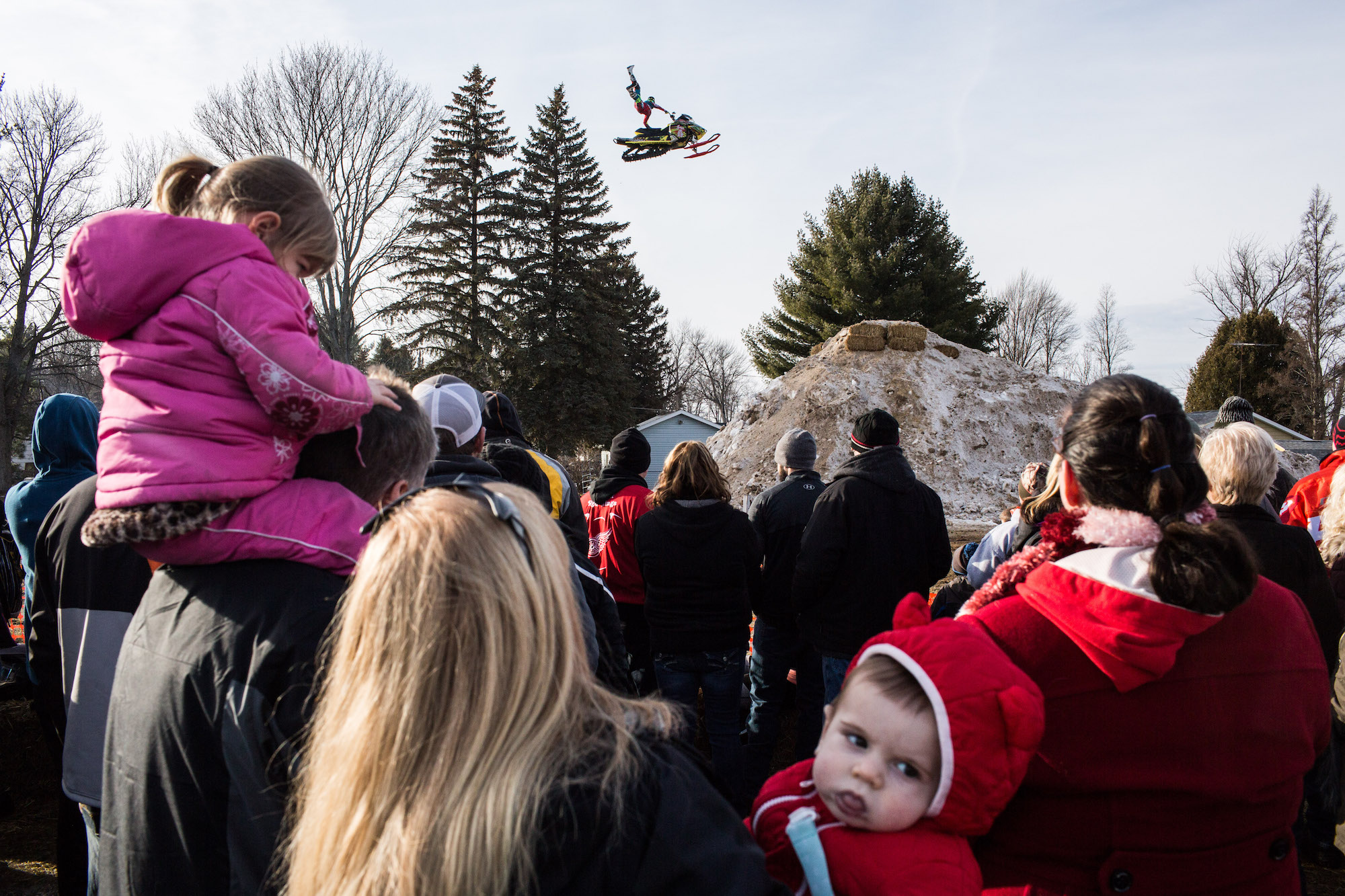
Double D has attended Tip Up Town since the 1970s, even being elected twice as mayor of the festival. He estimates that 10 years ago there would have been 500 snowmobiles out on the ice. This year, there were likely less than 100, due to a combination of the increased price of the vehicles and warming winter conditions.
Nearly 200 miles to the north, off the coast of the Upper Peninsula of Michigan, cold temperatures, lake effect snow, and sandstone cliffs work in tandem to create stunning 30-foot-tall curtains of blue and white sheets of ice, forming caves that attract spectators and ice climbers alike. But in the last few years, Lake Superior has often not been frozen enough to safely make the trek across to the ice caves, which are a half-mile offshore. Ice formations inland have also not been as safe for climbing.
In Wisconsin, long-distance dog sledding races have been canceled, leading the sport to shift to “dryland” racing, a shorter sprint event. Ice carving and winter festivals have been canceled in Wisconsin and Michigan. Cross-country skiing and snowshoeing seasons have been shortened.
For hundreds of years off the coast of Wisconsin, an “ice road” would connect Madeline Island — and its 300 full-time residents — to the mainland. When the waters of Lake Superior froze, people living on Madeline would walk or drive across the icy avenue. The frozen two-mile path allowed them access to medical care, schooling, and other necessities in the town of Bayfield, located at the tip of Wisconsin’s northern coast. But due to warmer temperatures, the road is becoming less dependable.
“Temperatures are the warmest they’ve been for many years,” Tom Irvine, executive director of the National Parks of Lake Superior Foundation, told Grist. “Up until the last four or five years, you could just drive cars and trucks across to the island. The last few years it’s been a lot more spotty.” When, or if, the lake does freeze up, Irvine said, the question then becomes: How long will it stay frozen, and how long will the ice stay safe? “Those activities that would happen on the lake are just restricted now. They’re either more dangerous or they can’t even be done at all.”

“There are cases all the time, on all the Great Lakes right now, [of] ice fishermen out on what they think is solid ice,” he said, “and all of a sudden a big flow of ice will crack off and they’ll float out into the lake. It’s a lot more perilous.”
In Minnesota, “land of 10,000 lakes,” these changes are impacting what is almost a rite of passage: hockey.
They start them early in Minnesota, with leagues for children as young as 5 years old. The state has long produced more National Hockey League players than any other.
For 16 years, this obsession has culminated in the U.S. Pond Hockey Championship on Lake Nokomis in Minneapolis, where hundreds of hockey teams compete for the prize of a seven-foot golden shovel with their names etched into it.
Before games start, opposing teams warm up by shoveling snow off the ice to create rinks. The tournament attracts tens of thousands of spectators every year, the crowd often withstanding temperatures well below freezing. This year, the teams included Lucille’s Frozen Assets, Mid Ice Crisis, and Not Fast Just Furious.
“In the winter here, everything is about hockey,” said Jesse Delorit, an event manager for the tournament alongside his wife, Judy. “We have people from all over the country, and all over the world, playing this event.”
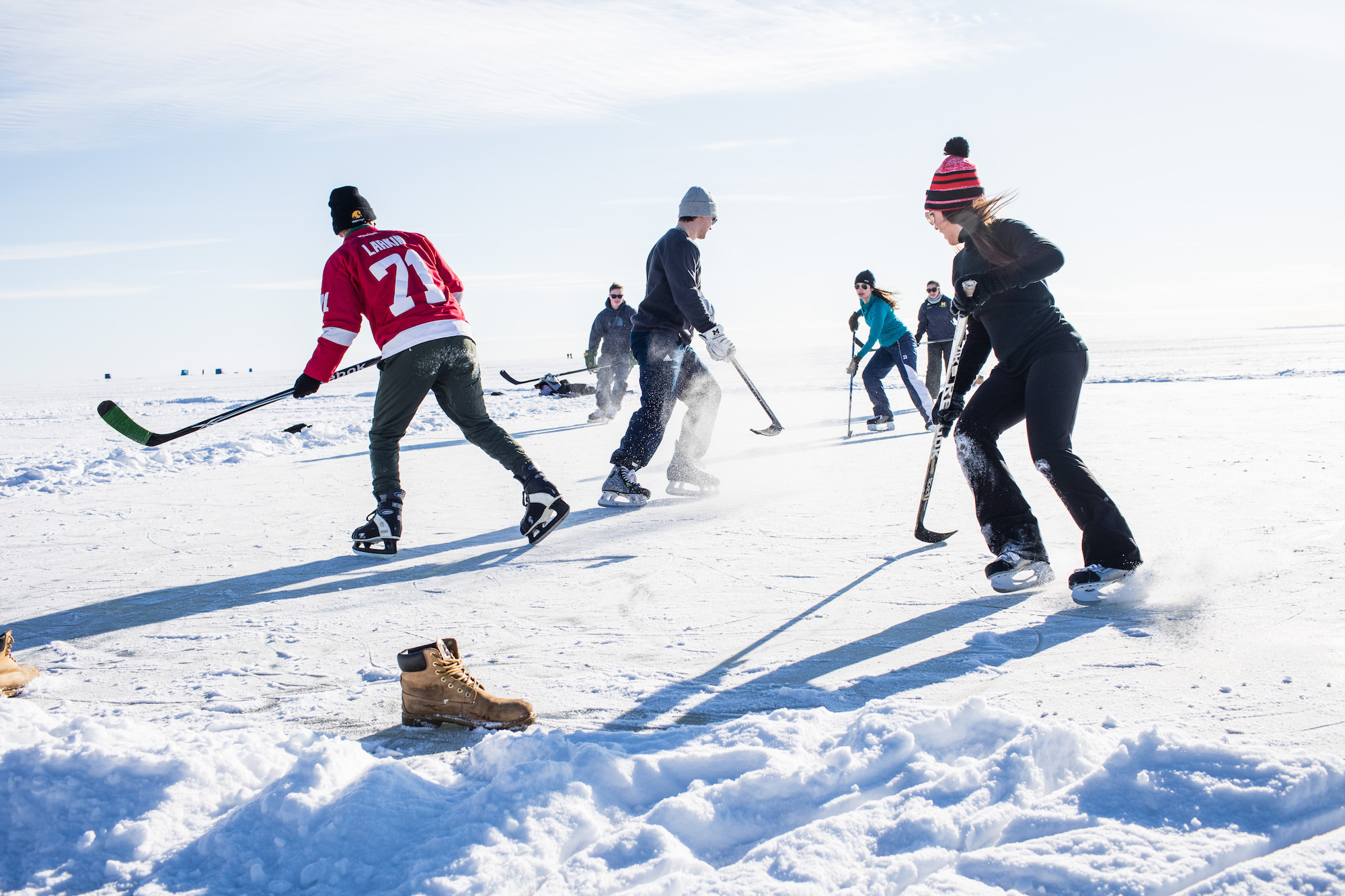
But in recent years, the timing of the tournament has become unpredictable. In 2012, the championship was almost canceled because of high temperatures and thin ice. In 2015, the event was rescheduled from mid-January to several weeks later because the ice wasn’t thick enough to support the players, all of the attendees, and the equipment. Organizers recently made the decision to more permanently shift the event’s start date back a few weeks, to buy more time for the lake to freeze, rather than having to make adjustments annually.
Player Mark Kuntz has traveled from New York to play in the championship every year since 2009. Competing on the ice, he said, is “surreal.” Leaving the locker room in the mornings, players are often greeted with a sundog — a rainbow patch of light created when the sun hits ice crystals in the air.
“It’s just one of the best places on earth for us, as hockey lovers,” he told Grist. But Kuntz said the conditions on the rinks have changed, remembering a year of so-called “slush games.” “There was like an inch or two of water on the rinks,” he said, “which is really tough to play in.”

Among the Midwest’s Indigenous communities, warming winters are affecting traditions that have been around for a lot longer than just a few decades.
Maple sugaring has long been a part of Ojibwe life. According to historical records, the Keweenaw Bay Band in 1865 sold 453,252 pounds of maple sugar to non-Indigenous businesses and buyers. Today, however, just one family on the reservation produces maple sugar: Jerry Jondreau and Katy Bresette.
Their farm, the 30-acre Dynamite Hill, has 730 taps in the trees collecting sap. Almost all get harvested by hand, versus an easier, vacuum technology system. Once the sap is harvested and taken back to the sugar house, it is placed over a wood-fired evaporator and brought to a boil. Then, the sap is filtered using orlon filters, instead of commercial filter presses, to maintain more of the nutrients.


Sap is harvested from sugar maple trees, left, and then placed over a wood-fired evaporator at Dynamite Hill Farms. Photos courtesy of Dynamite Hill Farms
“We are really trying to focus our efforts and energy towards revitalizing traditional foods, increasing access,” Jondreau said. ”But more importantly, also realizing our responsibilities to the land, as Anishinaabek people or as Ojibwe people. When you have a relationship with the land — the trees, the water, and fish — you notice when something’s not right, just like with your children or your family members. We’ve been noticing those changes, and it’s been sort of like double Dutch when it comes to the sugaring season.” The temperatures swing from warm to cold and make the season very unpredictable.
For centuries the maple sap has been harvested after the last freeze of the spring, typically in March.
Good conditions for sap flow happen when daytime temperatures are above freezing and nighttime temperatures are below. If it gets too warm and stops freezing at night, the trees stop producing sap. There’s a very narrow period of time when maple sap can be harvested — and Indigenous leaders like Jondreau and Katy Bresette say that period is getting shorter.
According to the northern Ojibwe lunar calendar, Iskigamizige giizis, or the sugar moon — when maple sap begins to run — typically takes place in March. “But we’ve been starting our sugaring operation in February,” said Jondreau, a forester by background and the tribe’s former forester, calling it “the new norm.”
“Climate change has just been making so many uncertainties prominent. Our trees, who respond to those temperature differences, are changing.”

All of this change — this melting and warming — has dampened the spirits and livelihood of hockey players, skiers, fishers, and the whole communities that rely on consistent cold weather for both their identities and economies.
“You spend more time trying to find good ice than you do fishing,” said Tony Muscioni, an ice fishing tour guide in Ohio. He lives just two miles from Lake Erie, where he’s fished for decades. Fishers flock to Muscioni’s area during the winter, hoping to catch walleye that can be found far offshore. Port Clinton, Ohio, is one of several places across the Midwest that claims to be “the walleye capital of the world.”
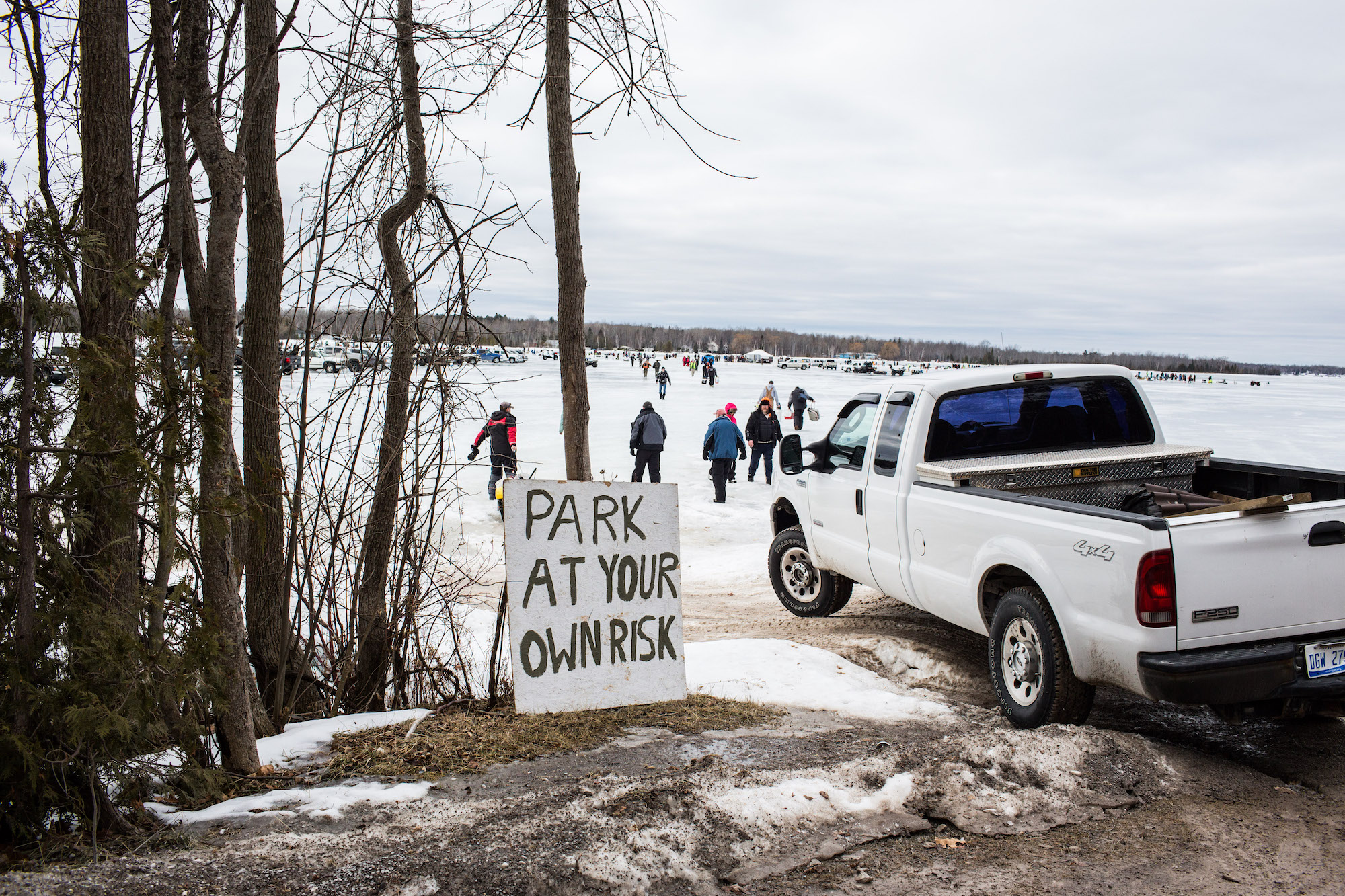
Usually, Muscioni can take people out to ice fish by mid-January. But in the last few years, the lake has been freezing later and later.
Mark Seeley, a former meteorologist and climatologist at the University of Minnesota, has been tracking these weather shifts for nearly 40 years. “It’s startling, what we are measuring and observing today,” he told Grist.
Temperatures this past December jumped from 66 degrees to sub-zero over the span of two weeks, setting a record. These extremes, sometimes called “weather whiplash,” are only getting worse: A heat index of 134 degrees F in Morehead, Minnesota in 2011. Or 15 inches of rain within 24 hours in Minnesota in 2007.
“I might see that once in a lifetime in a tropical latitude,” Seeley said, “but not in Minnesota.”
Gone are the winters that defined generations of Midwesterners.
Kevin Kling is a playwright and storyteller who grew up in Minnesota. “As a Minnesotan, you really either embraced the winter or you were in big trouble,” he said. Kling grew up playing ice hockey, sledding, and skiing. “We would go outside in the morning and we wouldn’t come back ’til night.”
His upbringing in the frigid temperatures helped shape Kling’s life work as a playwright.
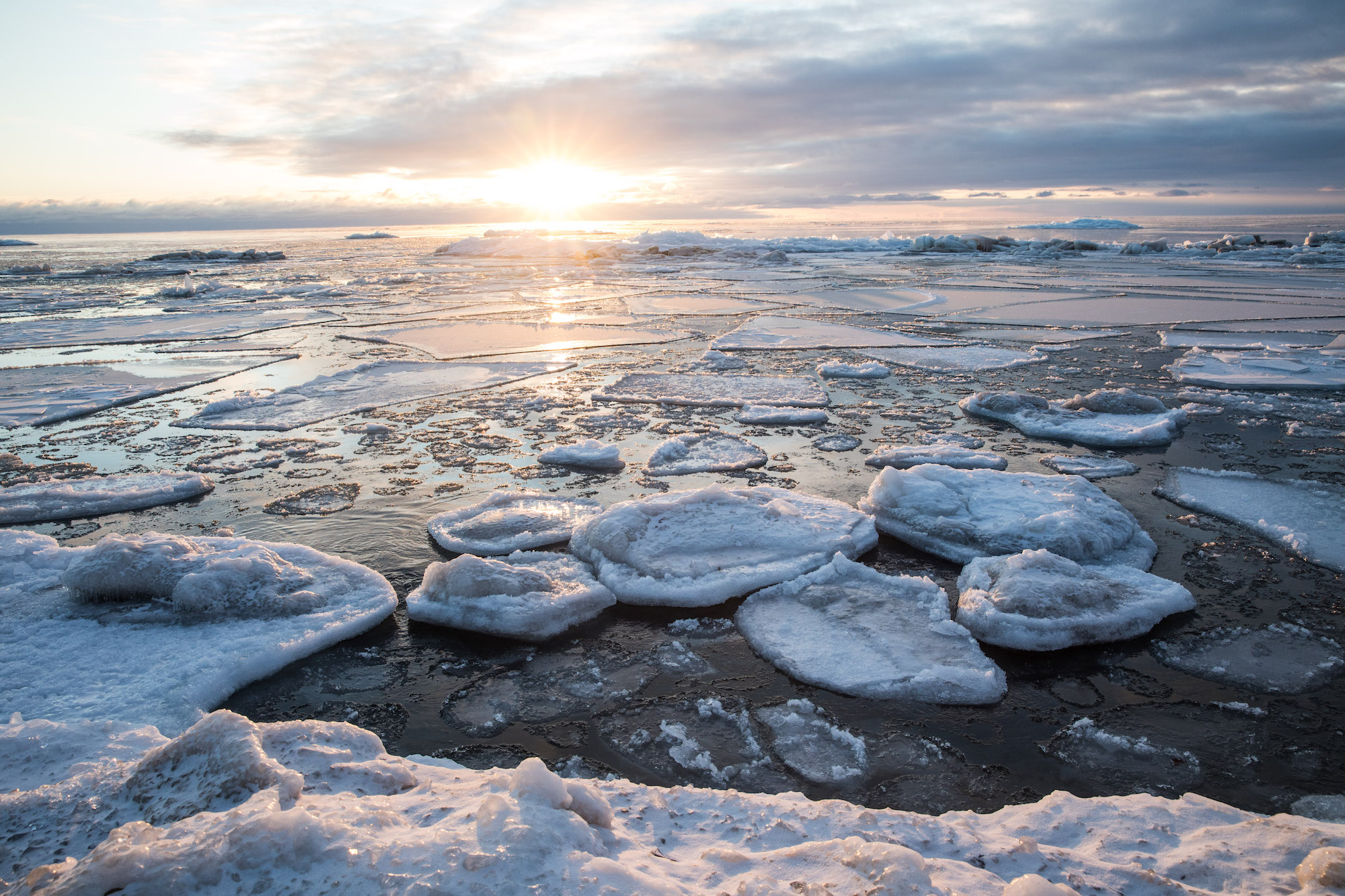
“When you have these long winters, it gives you time for reflection,” he said. “It’s a wonderful time of year, like the way the snow muffles the sound. There’s a reason it’s called a crisp night, because it feels like you’re right on the edge of shattering. It’s this most amazing feeling.”
Throughout his life, he’s been intimately aware of the shifts in climate. Ducks, for example, stay year-round these days. During warmer years, the water levels on Lake Superior fluctuate, as more water evaporates. Forests are moving north. And extreme weather is happening more often and with greater intensity.
For Kling, and many other folks in the Great Lakes region, these changes are having a profound effect on their sense of self.
“I still am able to get enough winter in, but I do feel that it is slipping.”
